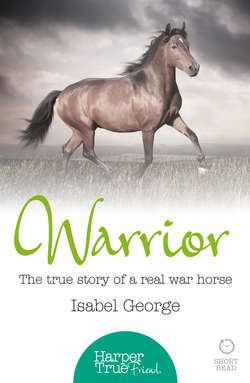Читать книгу Warrior: The true story of the real war horse - Isabel George, Isabel George - Страница 8
‘Three cheers for old Warrior!’
ОглавлениеAs the New Year rang in, Lord Kitchener requested Seely’s presence at the War Office in London. But Seely did not travel alone. In a gesture of respect for him and his war horse, Warrior was granted a pass home, too. According to Seely in his book Warrior: The Amazing Story of a Real War Horse, Sir John French – Commander in Chief of the British Expeditionary Forces – allowed the horse special passage and went as far as to say: ‘I owe much to your young horse … As long as I am Commander in Chief, wherever you go, he shall go.’
Warrior travelled back home to Mottistone to visit his mother, Cinderella. Seely went to the War Office where he received his orders for the next phase of the war – he was to command the Canadian Cavalry, which comprised all the men they could muster from the bravest and best of their cavalry regiments: Lord Strathcona’s Horse, the Fort Garry Horse, the Royal Canadian Dragoons and the Royal Canadian Horse Artillery. Kitchener shared the news that the Allies had experienced the first chlorine gas attack of the war during the Second Battle of Ypres and reinforcements were now urgently needed in the trenches. Seely and Warrior were to join the Canadians right away while they were training on Salisbury Plain, to help prepare them for Flanders.
General Seely was well respected by the Canadians, but his horse was respected even more. Warrior was immediately given the honour of regimental mascot, and whenever he appeared the men would shout, ‘Here comes Warrior!’ patting his flanks and cheering as he proudly trotted by. The men loved their horses and they were proud of the fine Canadian stock they had brought with them, so perhaps more than anyone else they understood Seely’s bond with Warrior. This made the generals’s first order to his men all the harder to deliver.
In the early months of the war it was the cavalry regiments that suffered the heaviest losses. The cavalry charge seen near Mons was such a tactical disaster that it could have been the last of the war. Waves of galloping horses ridden by men lunging swords were cut down at a distance by the relentless stutter of the German machine guns. The horses made easy targets and carnage was all that was achieved. Suddenly, the cavalry – regarded as the elite of the British Army – looked out of place, a throwback from a bygone military era. Modern trench warfare, with its barbed wire and advanced artillery, had changed the face of the fighting, and that is why, in February 1915, Seely had to ask his Canadian Cavalry soldiers to go to war without their horses.
As the men boarded the troopship at Southampton, Seely escorted Warrior onboard and eased him into a corridor where there was space enough to fit in next to him for the night crossing. It was a rough passage, and Seely was pleased that he could talk Warrior through it till dawn and offer him titbits of corn to keep his spirits up. It was 6 a.m. by the time the ship docked in Boulogne and the men could gather their kitbags ready to disembark. Several looked sick and were eager to plant their feet on dry land, but it was the General and Warrior who were the first down the gangway, positioning themselves so they could greet every man as they came ashore. There was little chatter as the men readied themselves and their belongings to move on to the next stage of their journey, but suddenly a shout went out: ‘Three cheers for Warrior!’ His rider must have felt the horse’s body rise with pride and his head lift to acknowledge the cheering of his name. It was nothing new for Jack Seely to hear his horse praised in this way. After all, Warrior was a remarkable and lovable horse, as his owner knew only too well.
